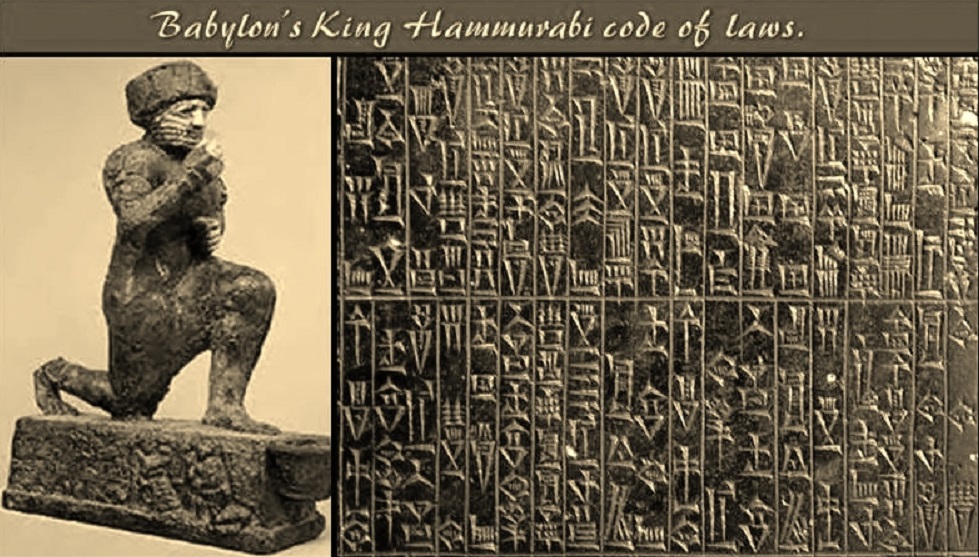
Hammurabi was the eldest son of Sin-Muballit and on the eighteenth century AD. became the VI king of Babylon in the moment that his father abdicated. Even if didn’t inherited a lot of power, controlling just a small part of Babylon, later would’ve become the first king of the Babylonian Empire.
It was a great leader and conqueror, but Hammurabi is best known as a great reformer and legislator. He created a set of laws called “Code of Hammurabi”, which is one of the oldest law codes. The term “Code of Hammurabi” is modern, named after “Code of Napoleon”.
Historians think that Hammurabi inspired by older laws code of Ur-Nammu, a king of Ur, writen about three centuries before. He also used his previous experiences of cases that he had judged.
These laws have helped the shape of babylonian culture and civilization, but their influence would reflect on the entire ancient world in the next millennium.
The code consists of more than 300 laws that discuss a comprehensive range of topics, including murder, assault, divorce, debt, adoptions, farming practices, even disputes about brewing.
The Code was found after some archaeological excavations in Iran. It was engraved on a black diorite star, 2.25 meters tall; it’s now at the Louvre Museum in Paris.
Originally the star was exibited at Sippar (modern Iraq) most likely in a important temple. In the past, Sippar was in the Sun’s god house. On top of the star is a image in which Hammurabi is standing in the front of this god and rays are coming out of his shoulders. Historians think that other stars would have been in other babylonian cities.
After the death of Hammurabi, the legal system has become a classic in the ancient world, and archaeologists have found examples of its laws on some tablets that were copied more than 1,000 years after the death of king.
In his vision, Hammurabi considered that the right to give those laws had been granted by the gods. Code was rough and uneven. The society was divided into three: the nobles class and land owners, middle class and poor and the last class was represented by slaves.
Death showed as punishment for no less than 30 criminalities. It was given for temple stealing or palace properties, even when was given refuge to a runaway slave . More than that, penalties were given according to the social status of the accuser and the accused. However, there was the presumption of innocence (practice surviving until today).
Sentences like an eye for an eye were given only if people involved had the same social status. For example, If an elite man mistreated an ordinary man, then he had to pay about a half a pound of silver as punishment. If an ordinary man hit an elite man, the punishment was much sharper. If someone hurted a slave, he was forced to pay a compensation to the owner, not the slave.
Women were not treated equally either. For example, if a married woman was pointed finger at because of a man, which however was not caught, she had to throw herself into the river to protect the honor of her husband. On the other hand, there were laws that allowed a woman to recieve inheritance (in this regard were more evolved than most ancient civilizations).
Laws were tough with the accuser too, not only to the accused, who was obliged to have evidence that supported his cause. In the situation that the accuser could not demonstrate that the accused is guilty of murder, then he would have been killed.
How Hammurabi could not be present in all processes of empire, a gathering of judges held his place. Judges were severely punished if they tried to change a verdict established by law.
The legal system was much before its time when was about subjects as divorce, property rights, the prohibition of incest; provided even a minimum wage. Hammurabi divided the empire in large regions managed by his trustfull commanders. In addition to that, there was a controlling authority independent that controlled local commanders for possible disobedience to the emperor’s laws.
Code of Hammurabi has helped develop a progressive educational system. Literacy of the empire people exploded. Babylonians citizens became some of the most educated and sophisticated at that time.
Despite of the fact that “Code of Hammurabi” is one of the most well written and advanced legal codes of antiquity, today he would be considered ridiculously rough, inhuman, sexist and in many cases, even irrational.


